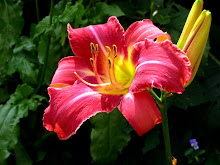
There are casual daylily fans who have a few Stellas or ditch lilies here and there in their yards; there are daylily obsessives, who grow many hundreds or thousands in meticulous showcase landscapes, know the names of every single cultivar they own and many they don’t (yet), and spend upwards of a hundred dollars for a single newly hybridized cultivar.
And then there’s everyone in between (probably the majority of us). I suppose most of us start out with having our eye caught by a particular blossom or two; for me, it was driving past a little daylily nursery farm on a narrow winding road on the north side of Cape Cod, years ago. I stopped to look, and that’s all it took.
Such colors! Such variety! Such lushness of foliage, abundance of blooms … I would go there once a week during the season, after getting my paycheck, and buy one or two. It would take me forever to select them; around and around the beds I went, wanting many more than I could possibly afford, trying to narrow it down.
The grower was a very large man named John, smoking and sweating and heaving himself around the beds as he dug up my choices, making me fear that he could have a heart attack at any moment … but his love for the flowers was infectious, his self-deprecating cheerfulness endearing.
I remember his excitement over one daylily in particular named Cookie Monster. He convinced me to buy it before any of the blooms had opened yet, trusting in his description of the multiple shades found in a polychrome. And he was right. It’s still one of my favorites, all these years later.
If you’re a daylily lover, or a collector of another type of plant, how did you get started? I’d love to hear your stories too.









